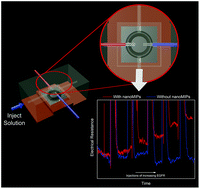Thermistors coated with molecularly imprinted nanoparticles for the electrical detection of peptides and proteins†
Abstract
In this communication, molecularly imprinted nanoparticles (nanoMIPs) that are produced by solid-phase synthesis are functionalised onto thermistors via dip-coating. These thermistors are soldered onto a printed-circuit board to facilitate electrical detection. Subsequently, these are inserted into a home-made thermal device that can measure the selective binding of biomolecules to the nanoMIP layer via monitoring the thermal resistance (Rth) at the solid–liquid interface. This thermal analysis technique, referred to as the Heat-Transfer Method, has previously been used for detection of proteins with MIP-based binders. While offering the advantages of low-cost and label free analysis, this method is limited by the high noise on the feedback loop and not being commercially available. These disadvantages can be overcome by the use of thermistors, which offer superior temperature sensitivity compared to thermocouples, and its electrical read-out can be easily integrated into portable devices. To our knowledge, this is the first report where MIPs are directly integrated onto thermistors for detection purposes. Measurements were conducted with an epitope of epidermal growth factor receptor (EGFR) and trypsin, where the electrical resistance was correlated to the biomolecule concentration. For both EGFR and trypsin, an enhanced signal to noise ratio for the electrical measurements was observed compared to previous analysis that was based on thermal resistance. The sensitivity of the sensors in buffered solution was in the nanomolar range, which is compatible with physiologically relevant concentrations. Upon exposure of the nanoMIP for EGFR towards pepsin no significant change in the resistance was yielded, establishing the selectivity of the developed sensor platform. Besides the enhanced sensitivity, the use of thermistors will enable miniaturisation of the device and has potential for in vivo measurements since specified electrochemical measurements are compatible with human use. To highlight the versatility of the nanoMIPs, this work should be extended to a set of biomolecules with various structures, with the possibility of extending this to an array format.



 Please wait while we load your content...
Please wait while we load your content...